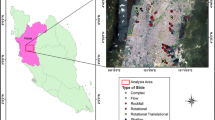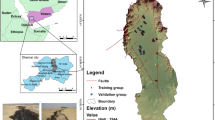Abstract
Rockfall is a common phenomenon in mountainous and hilly areas worldwide, including Malaysia. Rockfall source identification is a challenging task in rockfall hazard assessment. The difficulty rise when the area of interest has other landslide types with nearly similar controlling factors. Therefore, this research presented and assessed a hybrid model for rockfall source identification based on the stacking ensemble model of random forest (RF), artificial neural network, Naive Bayes (NB), and logistic regression in addition to Gaussian mixture model (GMM) using high-resolution airborne laser scanning data (LiDAR). GMM was adopted to automatically compute the thresholds of slope angle for various landslide types. Chi square was utilised to rank and select the conditioning factors for each landslide type. The best fit ensemble model (RF–NB) was then used to produce probability maps, which were used to conduct rockfall source identification in combination with the reclassified slope raster based on the thresholds obtained by the GMM. Next, landslide potential area was structured to reduce the sensitivity and the noise of the model to the variations in different conditioning factors for improving its computation performance. The accuracy assessment of the developed model indicates that the model can efficiently identify probable rockfall sources with receiver operating characteristic curve accuracies of 0.945 and 0.923 on validation and training datasets, respectively. In general, the proposed hybrid model is an effective model for rockfall source identification in the presence of other landslide types with a reasonable generalisation performance.
Graphic Abstract









Similar content being viewed by others
References
Abdulwahid WM, Pradhan B (2017) Landslide vulnerability and risk assessment for multi-hazard scenarios using airborne laser scanning data (LiDAR). Landslides 14(3):1057–1076. https://doi.org/10.1007/s10346-016-0744-0
Aghdam IN, Varzandeh MHM, Pradhan B (2016) Landslide susceptibility mapping using an ensemble statistical index (Wi) and adaptive neuro-fuzzy inference system (ANFIS) model at Alborz Mountains (Iran). Environ Earth Sci 75(7):553
Agliardi F, Riva F, Galletti L, Zanchi A, Crosta GB (2016) Rockfall source characterization at high rock walls in complex geological settings by photogrammetry, structural analysis and DFN techniques. EGU Gen Assem Conf Abstr 18:13071
Alves A (2017) Stacking machine learning classifiers to identify Higgs bosons at the LHC. J Instrum 12(05):T05005
Brenning A (2005) Spatial prediction models for landslide hazards: review, comparison and evaluation. Nat Hazards Earth Syst Sci 5(6):853–862. https://doi.org/10.5194/nhess-5-853-2005
Bui DT, Tuan TA, Klempe H, Pradhan Revhaug I (2016) Spatial prediction models for shallow landslide hazards: a comparative assessment of the efficacy of support vector machines, artificial neural networks, kernel logistic regression, and logistic model tree. Landslides 13(2):361–378. https://doi.org/10.1007/s10346-015-0557-6
Catani F, Casagli N, Ermini L, Righini G, Menduni G (2005) Landslide hazard and risk mapping at catchment scale in the Arno River basin. Landslides 2(4):329–342. https://doi.org/10.1007/s10346-005-0021-0
Chen Z, Gao B, Devereux B (2017) State-of-the-art: DTM generation using airborne LIDAR data. Sensors 17(1):150. https://doi.org/10.3390/s17010150
Chen W, Yan X, Zhao Z, Hong H, Bui DT, Pradhan B (2019) Spatial prediction of landslide susceptibility using data mining-based kernel logistic regression, naive Bayes and RBFNetwork models for the Long County area (China). Bull Eng Geol Environ 78(1):247–266. https://doi.org/10.1007/s10064-018-1256-z
Corona C, Trappmann D, Stoffel M (2013) Parameterization of rockfall source areas and magnitudes with ecological recorders: when disturbances in trees serve the calibration and validation of simulation runs. Geomorphology 202:33–42. https://doi.org/10.1016/j.geomorph.2013.02.001
Dickson ME, Perry GL (2016) Identifying the controls on coastal cliff landslides using machine-learning approaches. Environ Model Softw 76:117–127. https://doi.org/10.1016/j.envsoft.2015.10.029
Dieu TB, Tien-Chung H, Pradhan B, Pham BT, Nhu V-H, Revhaug I (2016) GIS-based modeling of rainfall-induced landslides using data mining-based functional trees classifier with AdaBoost, Bagging, and MultiBoost ensemble frameworks. Environ Earth Sci 75:1101
Dou J, Yamagishi H, Zhu Z, Yunus AP, Chen CW (2018) TXT-tool 1.081-6.1 a comparative study of the binary logistic regression (BLR) and artificial neural network (ANN) models for GIS-based spatial predicting landslides at a regional scale. In: Sassa K et al (eds) Landslide dynamics: ISDR-ICL landslide interactive teaching tools. Springer, Cham. https://doi.org/10.1007/978-3-319-57774-6_10
Evans JS, Hudak AT (2007) A multiscale curvature algorithm for classifying discrete return LiDAR in forested environments. IEEE Trans Geosci Sens 45(4):1029–1038. https://doi.org/10.1109/TGRS.2006.890412
Fanos AM, Pradhan B (2016) Multi-scenario rockfall hazard assessment using LiDAR data and GIS. Geotech Geol Eng 34(5):1375–1393. https://doi.org/10.1007/s10706-016-0049-z
Fanos AM, Pradhan B (2018) Laser scanning systems and techniques in rockfall source identification and risk assessment: a critical review. Earth Syst Environ 2(2):163–182
Fanos AM, Pradhan B, Aziz AA, Jebur MN, Park HJ (2016) Assessment of multi-scenario rockfall hazard based on mechanical parameters using high-resolution airborne laser scanning data and GIS in a tropical area. Environ Earth Sci 75(15):1129. https://doi.org/10.1007/s12665-016-5936-3
Fanos AM, Pradhan B, Mansor S, Yusoff ZM, bin Abdullah AF (2018) A hybrid model using machine learning methods and GIS for potential rockfall source identification from airborne laser scanning data. Landslides 15(9):1833–1850. https://doi.org/10.1007/s10346-018-0990-4
Giacomini A, Ferrari F, Thoeni K, Lambert C (2016) A new rapid method for rockfall energies and distances estimation. EGU Gen Assem Conf Abstr 18:5323
Gigli G, Morelli S, Fornera S, Casagli N (2014) Terrestrial laser scanner and geomechanical surveys for the rapid evaluation of rock fall susceptibility scenarios. Landslides 11(1):1–14. https://doi.org/10.1007/s10346-012-0374-0
Guzzetti F, Reichenbach P, Wieczorek GF (2003) Rockfall hazard and risk assessment in the Yosemite Valley, California, USA. Nat Hazards Earth Syst Sci 3(6):491–503
Hong H, Pradhan B, Xu C, Bui DT (2015) Spatial prediction of landslide hazard at the Yihuang area (China) using two-class kernel logistic regression, alternating decision tree and support vector machines. Catena 133:266–281. https://doi.org/10.1016/j.catena.2015.05.019
Kotthoff L, Thornton C, Hoos HH, Hutter F, Leyton-Brown K (2017) Auto-WEKA 2.0: automatic model selection and hyperparameter optimization in WEKA. J Mach Learn Res 18(1):826–830
Kromer R, Lato M, Hutchinson DJ, Gauthier D, Edwards T (2017) Managing rockfall risk through baseline monitoring of precursors using a terrestrial laser scanner. Can Geotech J 54(7):953–967. https://doi.org/10.1139/cgj-2016-0178
Lan H, Martin CD, Zhou C, Lim CH (2010) Rockfall hazard analysis using LiDAR and spatial modeling. Geomorphology 118(1–2):213–223. https://doi.org/10.1016/j.geomorph.2010.01.002
Lombardo L, Mai PM (2018) Presenting logistic regression-based landslide susceptibility results. Eng Geol 244:14–24. https://doi.org/10.1016/j.enggeo.2018.07.019
Lopez-Saez J, Corona C, Eckert N, Stoffel M, Bourrier F, Berger F (2016) Impacts of land-use and land-cover changes on rockfall propagation: insights from the Grenoble conurbation. Sci Total Environ 547:345–355. https://doi.org/10.1016/j.scitotenv.2015.12.148
Losasso L, Jaboyedoff M, Sdao F (2017) Potential rock fall source areas identification and rock fall propagation in the province of Potenza territory using an empirically distributed approach. Landslides 14(5):1593–1602. https://doi.org/10.1007/s10346-017-0807-x
Loye A, Jaboyedoff M, Pedrazzini A (2009) Identification of potential rockfall source areas at a regional scale using a DEM-based geomorphometric analysis. Nat Hazards Earth Syst Sci 9(5):1643–1653. https://doi.org/10.5194/nhess-9-1643-2009
Manzo G, Tofani V, Segoni S, Battistini A, Catani F (2013) GIS techniques for regional-scale landslide susceptibility assessment: the Sicily (Italy) case study. Int J Geogr Inf Sci 27(7):1433–1452. https://doi.org/10.1080/13658816.2012.693614
Massey CI, McSaveney MJ, Taig T, Richards L et al (2014) Determining rockfall risk in Christchurch using rockfalls triggered by the 2010–2011 Canterbury earthquake sequence. Earthq Spectra 30(1):155–181. https://doi.org/10.1193/021413EQS026M
Messenzehl K, Meyer H, Otto JC, Hoffmann T, Dikau R (2017) Regional-scale controls on the spatial activity of rockfalls (Turtmann valley, Swiss Alps)—a multivariate modeling approach. Geomorphology 287:29–45. https://doi.org/10.1016/j.geomorph.2016.01.008
Mitchell A, Hungr O (2016) Theory and calibration of the Pierre 2 stochastic rock fall dynamics simulation program. Can Geotech J 54(1):18–30. https://doi.org/10.1139/cgj-2016-0039
Mohammady M, Pourghasemi HR, Pradhan B (2012) Landslide susceptibility mapping at Golestan Province, Iran: a comparison between frequency ratio, Dempster–Shafer, and weights-of-evidence models. J Asian Earth Sci 61(SI):221–236
Mote TI, Skinner MD, Taylor ML, Lyons C (2019) Site-specific rockfall risk assessments and rockfall protection structure design following the 2010/2011 Canterbury earthquake sequence. In: IAEG/AEG annual meeting proceedings, San Francisco, California, 2018, vol 5. Springer, Cham, pp 143–152
Olsen M, Wartman J, McAlister M et al (2015) To fill or not to fill: sensitivity analysis of the influence of resolution and hole filling on point cloud surface modeling and individual rockfall event detection. Remote Sens 7(9):12103–12134. https://doi.org/10.3390/rs70912103
Park SJ, Lee CW, Lee S, Lee MJ (2018) Landslide susceptibility mapping and comparison using decision tree models: a case study of Jumunjin Area, Korea. Remote Sens 10(10):1545. https://doi.org/10.3390/rs10101545
Pellicani R, Spilotro G, Van Westen CJ (2016) Rockfall trajectory modeling combined with heuristic analysis for assessing the rockfall hazard along the Maratea SS18 coastal road (Basilicata, Southern Italy). Landslides 13(5):985–1003. https://doi.org/10.1007/s10346-015-0665-3
Pham BT, Pradhan B, Bui DT, Prakash I, Dholakia MB (2016) A comparative study of different machine learning methods for landslide susceptibility assessment: a case study of Uttarakhand area (India). Environ Model Softw 84:240–250. https://doi.org/10.1016/j.envsoft.2016.07.005
Pradhan B, Fanos AM (2017a) Application of LiDAR in rockfall hazard assessment in tropical region. In: Pradhan B (ed) Laser scanning applications in landslide assessment. Springer, Cham, pp 323–359. https://doi.org/10.1007/978-3-319-55342-9_16
Pradhan B, Fanos AM (2017b) Rockfall hazard assessment: an overview. In: Pradhan B (ed) Laser scanning applications in landslide assessment. Springer, Cham, pp 299–322. https://doi.org/10.1007/978-3-319-55342-9
Pradhan B, Lee S (2010) Regional landslide susceptibility analysis using back-propagation neural network model at Cameron Highland, Malaysia. Landslides 7(1):13–30
Pradhan B, Sezer EA, Gokceoglu C, Buchroithner MF (2010) Landslide susceptibility mapping by neuro-fuzzy approach in a landslide-prone area (Cameron Highlands, Malaysia). IEEE Trans Geosci Remote Sens 48(12):4164–4177. https://doi.org/10.1109/TGRS.2010.2050328
Pradhan B, Abokharima MH, Jebur MN, Tehrany MS (2014) Land subsidence susceptibility mapping at Kinta Valley (Malaysia) using the evidential belief function model in GIS. Nat Hazards 73(2):1019–1042. https://doi.org/10.1007/s11069-014-1128-1
Reynolds D (2015) Gaussian mixture models. Encyclopedia of biometrics, pp 827–832
Scrucca L, Fop M, Murphy TB, Raftery AE (2016) mclust 5: clustering, classification and density estimation using Gaussian finite mixture models. R J 8(1):289
Segoni S, Tofani V, Rosi A, Catani F, Casagli N (2018) Combination of rainfall thresholds and susceptibility maps for dynamic landslide hazard assessment at regional scale. Front Earth Sci 6:85
Simon N, Ghani MFA, Hussin A et al (2015) Assessment of rockfall potential of limestone hills in the Kinta Valley. JSSM 10(2):24–34
Trigila A, Frattini P, Casagli N et al (2013) Landslide susceptibility mapping at national scale: the Italian case study. In: Margottini C, Canuti P, Sassa K (eds) Landslide science and practice. Springer, Berlin, pp 287–295
Truong X, Mitamura M, Kono Y et al (2018) Enhancing prediction performance of landslide susceptibility model using hybrid machine learning approach of bagging ensemble and logistic model tree. Appl Sci 8(7):1046. https://doi.org/10.3390/app8071046
Varnes DJ (1984) Landslide hazard zonation: a review of principles and practice. Natural hazards, No 3. United Nations Publisher, Paris
Wen Z, He B, Xu D, Feng Q (2016) A method for landslide susceptibility assessment integrating rough set and decision tree: a case study in Beichuan, China. In: 2016 IEEE international geoscience and remote sensing symposium (IGARSS). IEEE, pp 4952–4955. https://doi.org/10.1109/igarss.2016.7730292
Zare M, Pourghasemi HR, Vafakhah M, Pradhan B (2013) Landslide susceptibility mapping at Vaz Watershed (Iran) using an artificial neural network model: a comparison between multilayer perceptron (MLP) and radial basic function (RBF) algorithms. Arab J Geosci 6(8):2873–2888
Acknowledgements
The authors acknowledge and appreciate the provision of airborne laser scanning data orthophoto images from airborne laser scanning data (LiDAR) by the Department of Planning.
Funding
This research is supported by the Centre for Advanced Modelling and Geospatial Information Systems (CAMGIS) in the University of Technology Sydney (UTS) under Grants 321740.2232335 and 321740.2232357.
Author information
Authors and Affiliations
Corresponding author
Rights and permissions
About this article
Cite this article
Fanos, A.M., Pradhan, B. A Novel Hybrid Machine Learning-Based Model for Rockfall Source Identification in Presence of Other Landslide Types Using LiDAR and GIS. Earth Syst Environ 3, 491–506 (2019). https://doi.org/10.1007/s41748-019-00114-z
Received:
Accepted:
Published:
Issue Date:
DOI: https://doi.org/10.1007/s41748-019-00114-z




